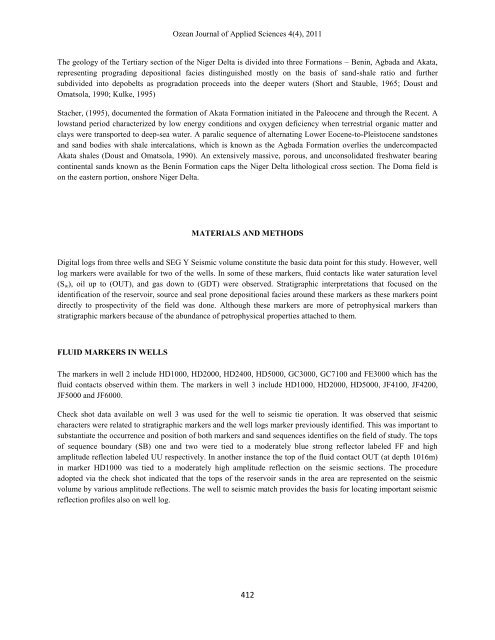download current issue - Ozean Publications
download current issue - Ozean Publications
download current issue - Ozean Publications
You also want an ePaper? Increase the reach of your titles
YUMPU automatically turns print PDFs into web optimized ePapers that Google loves.
<strong>Ozean</strong> Journal of Applied Sciences 4(4), 2011<br />
The geology of the Tertiary section of the Niger Delta is divided into three Formations – Benin, Agbada and Akata,<br />
representing prograding depositional facies distinguished mostly on the basis of sand-shale ratio and further<br />
subdivided into depobelts as progradation proceeds into the deeper waters (Short and Stauble, 1965; Doust and<br />
Omatsola, 1990; Kulke, 1995)<br />
Stacher, (1995), documented the formation of Akata Formation initiated in the Paleocene and through the Recent. A<br />
lowstand period characterized by low energy conditions and oxygen deficiency when terrestrial organic matter and<br />
clays were transported to deep-sea water. A paralic sequence of alternating Lower Eocene-to-Pleistocene sandstones<br />
and sand bodies with shale intercalations, which is known as the Agbada Formation overlies the undercompacted<br />
Akata shales (Doust and Omatsola, 1990). An extensively massive, porous, and unconsolidated freshwater bearing<br />
continental sands known as the Benin Formation caps the Niger Delta lithological cross section. The Doma field is<br />
on the eastern portion, onshore Niger Delta.<br />
MATERIALS AND METHODS<br />
Digital logs from three wells and SEG Y Seismic volume constitute the basic data point for this study. However, well<br />
log markers were available for two of the wells. In some of these markers, fluid contacts like water saturation level<br />
(S w ), oil up to (OUT), and gas down to (GDT) were observed. Stratigraphic interpretations that focused on the<br />
identification of the reservoir, source and seal prone depositional facies around these markers as these markers point<br />
directly to prospectivity of the field was done. Although these markers are more of petrophysical markers than<br />
stratigraphic markers because of the abundance of petrophysical properties attached to them.<br />
FLUID MARKERS IN WELLS<br />
The markers in well 2 include HD1000, HD2000, HD2400, HD5000, GC3000, GC7100 and FE3000 which has the<br />
fluid contacts observed within them. The markers in well 3 include HD1000, HD2000, HD5000, JF4100, JF4200,<br />
JF5000 and JF6000.<br />
Check shot data available on well 3 was used for the well to seismic tie operation. It was observed that seismic<br />
characters were related to stratigraphic markers and the well logs marker previously identified. This was important to<br />
substantiate the occurrence and position of both markers and sand sequences identifies on the field of study. The tops<br />
of sequence boundary (SB) one and two were tied to a moderately blue strong reflector labeled FF and high<br />
amplitude reflection labeled UU respectively. In another instance the top of the fluid contact OUT (at depth 1016m)<br />
in marker HD1000 was tied to a moderately high amplitude reflection on the seismic sections. The procedure<br />
adopted via the check shot indicated that the tops of the reservoir sands in the area are represented on the seismic<br />
volume by various amplitude reflections. The well to seismic match provides the basis for locating important seismic<br />
reflection profiles also on well log.<br />
412

















